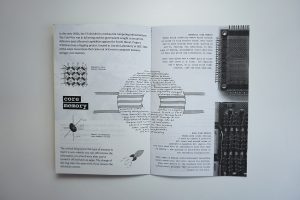While researching early forms of computer memory for the 2018 Woolpunk Congress, I came across a woman named Hilda G. Carpenter, an African American lab technician at MIT. She was part of a research group that was investigating how small magnetic rings could be used to store memory by weaving wires through them. Indeed, Hilda wove the first plane of this magnetic core memory and dozens more during her time there. Their research was a great success – this was the memory that would eventually be used to land Apollo missions on the moon among other things. In reading recorded interviews of the men who participated in the research group, some mentioned this one woman whose efficiency and productive prowess contributed invaluably to their success. They remembered her name was Hilda – maybe – but could not remember her last name. After weeks of research, I uncovered few documents in the digital archive I could use to thread her story together. This zine captures all of them that I could find.
Throughout history, women’s voices have gone unrecorded, leaving a wide narrative gap that could expose alternative perspectives, power structures, and futures. This is especially evident in computing and engineering history where women served in secondary roles, relegated to positions that exercised their fingers instead of cultivating their intellect. Over the last decade, stories of famous historical female programmers and engineers have emerged, but the list rarely grows or changes. While these women made unquestionably important contributions, I am more interested in the women and female-identifying people whose stories we haven’t heard. For example, the Little Old Ladies or LOLs who wove all of that magnetic or rope core memory. This zine is for them and it is dedicated to Hilda. It is an an early attempt to build a new archive, to surface a new history through old voices. You can read it here.
References
DiNolfo, R. S. (n.d.). Multi-Coordinate Selection Systems for Magnetic-Core Storage. Retrieved November 20, 2018, from http://dome.mit.edu/handle/1721.3/40247
Draper Laboratories. (1962, c). LINC (Laboratory Instrument Computer) development group. Retrieved September 23, 2018, from http://www.computerhistory.org/collections/catalog/102622651
Electronics: Magnetic Cores I: Properties 1961 US Army Training Film. (1961). Retrieved November 20, 2018, from https://www.youtube.com/watch?v=X0WnddW5gZI
Fildes, J. (n.d.). Weaving the way to the Moon. BBC News. Retrieved from http://news.bbc.co.uk/2/hi/technology/8148730.stm
Guditz, E. A., & Smith, L. B. (1956). Vacuum and Vibration Speed Assembly of Core Memory Planes. Electronics. Retrieved from http://dome.mit.edu/handle/1721.3/40242
Hilda Carpenter Obituary. (2013, August 23). Retrieved from http://www.legacy.com/obituaries/timesunion/obituary.aspx?pid=166570014
Monteiro, S. (2017). The Fabric of Interface: Mobile Media, Design, and Gender. Cambridge, MA: MIT Press.
Nakamura, L. (2014a). Indigenous Circuits: Navajo Women and the Racialization of Early Electronic Manufacture. American Quarterly, 66(4), 919–941. https://doi.org/10.1353/aq.2014.0070
oisiaa. (2011, March 16). Weaving software into core memory by hand. Retrieved October 1, 2018, from https://www.youtube.com/watch?v=P12r8DKHsak











